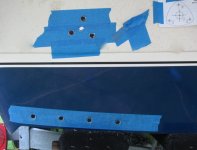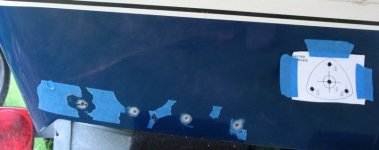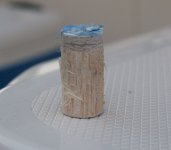Over the years I've been asked many times why I did some job myself rather than just paying to have it done. Sometimes I do it to save money but often I do it myself just so I know it was done properly and I won't have to worry about it in the future. This is a perfect example of that, why I should have installed the trim tabs myself rather than ordering them on the boat.
First let me say this. I've never owned a boat with trim tabs and I'm not convinced they are necessary on a 22' boat. My experiences with trim tabs have all been aboard other people's boats, all larger than the 22 Angler. For the most part my observations of their use has been, a. the operator never touched them, b. the operator fiddled with them constantly and I couldn't see that they made any difference, or c. they were broken.
With that in mind I had originally planned to order the boat without trim tabs and install them myself in the future should I decide that I needed or wanted them. After talking with the dealer about what installation entailed I decided to just order them from the factory. I wish I had waited and done it myself.
The last thing I wanted to get done before launching my C-Dory for the first time was fixing a couple of stripped screws in the hinge plates (where the trim tab is attached to the hull). I figured whoever installed them got carried away with the electric screwdriver and just stirpped the hole. While that is probably the case, here is what I found when I pulled the two screws.

See where my thumbnail touched that toothpick? That's how deep the hole is. That's the mounting screw beside it. The other stripped screw was the same. There was the usual goop type sealer at the mouth of the hole and approximated 1/8 inch into the hole.
When I'm drilling a blind hole for a mounting screw, particularly into the hull, after selecting the proper diameter bit I lay the screw along side the drill bit and wrap a piece of tape around the bit to let me know how deep to drill. It usually takes less than 30 seconds and prevents voids in the hull that can weaken it or allow water to collect that can cause blisters, delamination or rot in the balsa core.
Had I done this job myself there wouldn't be twelve one inch long voids in my hull to cause trouble in the future.
ACK!
First let me say this. I've never owned a boat with trim tabs and I'm not convinced they are necessary on a 22' boat. My experiences with trim tabs have all been aboard other people's boats, all larger than the 22 Angler. For the most part my observations of their use has been, a. the operator never touched them, b. the operator fiddled with them constantly and I couldn't see that they made any difference, or c. they were broken.
With that in mind I had originally planned to order the boat without trim tabs and install them myself in the future should I decide that I needed or wanted them. After talking with the dealer about what installation entailed I decided to just order them from the factory. I wish I had waited and done it myself.
The last thing I wanted to get done before launching my C-Dory for the first time was fixing a couple of stripped screws in the hinge plates (where the trim tab is attached to the hull). I figured whoever installed them got carried away with the electric screwdriver and just stirpped the hole. While that is probably the case, here is what I found when I pulled the two screws.

See where my thumbnail touched that toothpick? That's how deep the hole is. That's the mounting screw beside it. The other stripped screw was the same. There was the usual goop type sealer at the mouth of the hole and approximated 1/8 inch into the hole.
When I'm drilling a blind hole for a mounting screw, particularly into the hull, after selecting the proper diameter bit I lay the screw along side the drill bit and wrap a piece of tape around the bit to let me know how deep to drill. It usually takes less than 30 seconds and prevents voids in the hull that can weaken it or allow water to collect that can cause blisters, delamination or rot in the balsa core.
Had I done this job myself there wouldn't be twelve one inch long voids in my hull to cause trouble in the future.
ACK!



